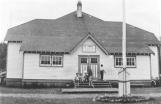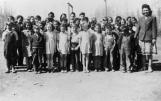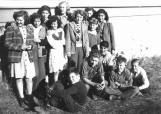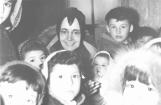1
Welcome to St. John's Roman Catholic School!St. John's Roman Catholic School was the first separate school in Fort McMurray. This school provided education which was often of a higher quality than the public schools', thanks to the work of the Grey Nuns of Montreal. From its opening in 1936 until its closure in the 1990s, St. John's school shaped the childhoods of many of the community's residents.
2
Five children outside St. John's Roman Catholic School1936-1950
St. John's Roman Catholic School, Fort McMurray, Alberta, Canada
 Credits:
Credits:School Reunion
Fort McMurray Historical Society
3
Establishing the School DistrictBishop Gabriel Breynat and Bishop Paul Piché were influential in establishing St. John's Separate School. Both men had a passion for opening Catholic schools throughout northern Canada. Bishop Piché said of the initiative, "Parents have the obligation to guide the moral development of their children and they have the right to expect that the moral and religious principals which they teach at home will be held before the children in school. The Universal Declaration of Human Rights declares that 'Parents have prior right to choose the kind of education that shall be given to their children and are entitled to protection by society and the state.' It is a fundamental principle that the greatest importance be attached by the state to the wishes and views of the parents of the students."
When Bishop Breynat promised Fort McMurray's citizens that he would work toward bringing in a Sisters' Hospital, he did so on one condition: the Catholic community in Fort McMurray must establish a separate school board and open a Catholic school.
Frank O'Coffey wrote to Bishop Breynat in Edmonton on 18 October 1934. The purpose of his letter was to discuss creating a separate school district in Fort McMurray. In further letters, O'Coffey suggested that creating this district would be affordable. Bishop Breynat responded favourably. On 28 September 1935, 31 interested ratepayers gathered in McVittie Hall to vote on the creation of a separate school district. With votes 29 for the new school district and 2 against, the Catholic ratepayers agreed on forming the new separate school district. Frank O'Coffey, James O'Hara, and Lina McDonald made up the first Board of Trustees, while Father Chouinard OMI served as Secretary-Treasurer.
The province's Department of Education ordered the establishment of St. John's Roman Catholic Separate School District No. 32 on 8 October 1935, but it was not until the following year that construction could begin.
4
Class picture at St. John's Roman Catholic School1944-1945
Fort McMurray, Alberta, Canada
 Credits:
Credits:Doris Somers
School Reunion
Fort McMurray Historical Society
5
Opening the SchoolIn August of the 1936, building began. The District would have started sooner, but they were delayed by legal difficulties: the Crown owned four acres of the land on which the school was to be built. After much negotiation and fundraising, the District purchased that property for $100, or $25 per acre.
Because of the delays, the construction was not completed by September, so for the first two weeks, St. John's School's 43 students had to use St. John's Catholic Church as a classroom. Mary Redmond's Junior students sat on the kneelers and used the benches as their desks while Wilfred Louiselle taught his Senior students in the choir loft.
On 26 September 1936, the St. John's School building was ready, and class moved into the school. It was a two-room building, and had very few supplies. Mr. Louiselle, the Principal and Senior Teacher, fell ill in November and left Fort McMurray in December. Mr. Duchak replaced him as Principal and Senior Teacher in January 1937. The Junior Teacher taught grades one to four, while the Senior Teacher taught grades five to eleven.
The enrollment of the first academic year (1936-1937) was as follows: Rosie Auger, Archie Goodwin, Wilfred Laboucane, Sarah Newsam, Myrtle Pacquette, Josephine Short, Bella Auger, Margaret Desrosier, John Hainault, Antoniette Martin, Evelyn O'Hara, Arthur McDonald, Jella Newsam, Harry O'Hara, Henry Townan, Gilbert McDougal, Martha Auger, Lawrence Laboucane, Angus Larocque, Elsie Hainault, George Auger, Marian Castor, Lena Castor, Rollo Goodwin, Irene Hainault, Fred McDonald, Elizabeth Powder, Julia Powder, Christine McDonald, Lina Shott, Yvonne Valcourt, Lawrence Auger, William Castor, Johnny Ducharme, Leo Dusseault, Marcel Dusseault, Louise Fontaine, George Griguiser, Victor Griguiser, Florence Laboucane, Margaret McDonald, Mary Jean McDonald, and Germaine Somers.
6
Mary Redmond, the First Junior TeacherMary Redmond was the first Junior Teacher at St. John's. She had taught for three and a half years at Tiviere Qui Barre before heading to Fort McMurray in 1936. She remembers that on the last stage of the journey, at Cooking Lake, she got into a float plane with the famous First World War flier and bush pilot "Wop" May, and with Con Farrell, another renowned pilot. After a three hour flight they landed on the Snye in Fort McMurray.
Redmond taught grades one to four, consisting of 30 pupils that first year. Supplies were scarce. She remembers using a piece of chalk until it was so short that her fingers scraped the board. For Christmas 1936, Mary took her first trip out of Fort McMurray into Edmonton, where she visited Woolsworth. There she bought school supplies, including pictures for the wall. However, she did not buy a wastebasket, so they used an apple box that she covered with pictures cut out from an Eaton's Catalogue.
Redmond once went walking with a friend in the winter, and when they got to MacDonald Island they built a campfire. Redmond managed to soak one of her mukluks. Her foot froze and was frostbitten. For weeks after that her students retrieved her from her home using a dog sled, and then took her home after class. She moved to Edmonton in 1940.
7
Grade 8 class picture at St. John's Roman Catholic School1947
St. John's Roman Catholic School, Fort McMurray, Alberta, Canada
 Credits:
Credits:School Reunion
Fort McMurray Historical Society
8
Early DevelopmentsIn the 1937-1938 school year, St. John's added grade eleven to its curriculum, accepting three students into this grade. The following year, they added a grade twelve program, in which two students enrolled. By the academic year beginning in 1939, three students were studying in grade twelve. At this time Peter Pond School, Fort McMurray's public school, did not offer higher than grade ten.
In June 1940, both Duchak and Redmond left Fort McMurray. Duchak joined the Air Force and Redmond left to teach in Edmonton. St. John's cancelled its grade eleven and twelve programs at the same time because those students who would have enrolled in these classes had enlisted or were filling in the employment gaps left by those who had. It was not until the Second World War ended that St. John's added these grades back into the curriculum.
Due to financial difficulties, the District could not afford to give high wages. In addition to this, living and working conditions in Fort McMurray were lower than most Canadians expected. These factors made it difficult for the District to hire male teachers, especially ones with families to support. As such they tended to rely on young, single female teachers. Even then they had difficulty finding anyone willing to risk the move to northern Alberta. Struggling to find staff, the District turned to a resource they felt they could rely on: the Grey Nuns of Montreal.
10
Financial PerilWhen the ratepayers decided to establish a separate school, the financial situation looked promising. Within a few years of the school's opening, however, population changes jeopardized the District's survival and put stress on all of the school districts in the area.
In the late 1930s, Fort McMurray as we know it today was still divided into several separate communities, particularly Fort McMurray and Waterways. Most of the ratepayers lived in Waterways, so when a new public School District opened in Waterways in the fall of 1938, many of them switched to the new district. While it was not a Catholic school, it was closer. St. John's Separate School Board still had debt outstanding from the land purchase and the building construction, and now there were fewer ratepayers to cover that debt. In December 1939, yet another public district opened in Abasand, resulting in even fewer ratepayers.
In January 1940, 57 students were enrolled in St. John's. The District's assets totaled $8,844.35, while its debts totaled $9,378.92 and its annual operation costs sat at $2,200.00. Because the public district was also struggling financially due to the split population, some citizens began encouraging consolidation. Father Chouinard OMI was hesitant about merging the districts, however, because he believed it was important to include religious education in schools. Bishop Breynat OMI petitioned for, and received, funds from the Catholic Church Extension Society in Toronto. These funds, combined with donations from local people and businesses like the Ryan Brothers, covered the debts and allowed the school to remain open.
Even after this initial crisis was averted, the District was repeatedly challenged by a growing population and the resultant housing shortages. St. John's Roman Catholic School Board struggled to cover debts and additional costs until 1979, when Bill 76 granted Catholic school funding per pupil at a rate equal to the public schools.
11
Grey Nun, likely Sister Evelyne Gagnon, with children1934-1945
St. John's Roman Catholic School, Fort McMurray, Alberta, Canada
 Credits:
Credits:School Reunion
Fort McMurray Historical Society
12
The Grey Nuns ArriveIn 1947, the School Board discussed getting a Community of Sisters to teach St. John's students and they discussed building a residence for them. Father Lesage wrote to the Mother Superior of the Grey Nuns of Montreal in 1948, requesting that they take over the teaching of St. John's Roman Catholic School. After deliberation and prayer, the Grey Nuns of Montreal accepted and in August 1949 they sent Sister Marie Boulet and Mother Courville. Sister Boulet at that time had 28 years of experience teaching in western Canada. They also promised to send Miss Antoinette Aquin as an assistant before school began. While the school continued to employ some lay people as teachers--in particular, single women--the Grey Nuns took on much of the teaching themselves and also formed the school's administration. They received $100 per month in wages, but returned that money directly to the Board for hiring lay teachers. In essence, the nuns worked for free.
The Grey Nuns would depart in 1971, but other orders of nuns served in the Fort McMurray Catholic schools in the years following the Grey Nuns' departure. Nuns from the Sisters of the Holy Cross, the Sisters of Service, and the Sisters of St. Martha all taught in Fort McMurray Catholic schools.
13
Four nuns and two children near St. John's Roman Catholic Schoolcirca 1960
Fort McMurray, Alberta, Canada
 Credits:
Credits:School Reunion
Fort McMurray Historical Society
14
Growth and AdditionsAt the end of the 1940s, the Board realized they needed to upgrade St. John's from a two-room schoolhouse to something larger. When construction began on the new St. John's Church in 1949, the lay brothers, under Brother Bruyère, also added two new rooms to St. John's school. This addition cost $11,314.00. Bishop Trocellier lent $5,908.00 to the Board to help ease the financial pressure. The Board also purchased a used 34-passenger bus, which James Hutchinson drove.
In 1949, Father Lesage succeeded in establishing St. Peter's Roman Catholic School District in Waterways. This meant that the Catholic students in Waterways no longer attended the Waterways school. Instead they attended St. John's school, beginning in September 1950. Unsure of how many children would arrive from Waterways, the Board decided that three teachers--Sister Boulet, Miss Carmen Turcotte, and Miss Therese Desrosiers--would have to suffice. When 107 students arrived, the Board began looking for another teacher, and Miss Blache Regimbalde arrived in October.
Due to the influx of students, the Board yet again discussed adding another classroom. Brother Bruyère had left room on the second floor. The Board, however, had to ask for approval from the Provincial Department of Education before they could use the second floor. The Department denied approval, but St. John's used it as a classroom in 1951 anyway because enrollment was still high. That year, there were five teachers: Sister Marie Boulet, Miss Laurette Marquis, Miss Germaine Somers, Miss Therese Desrosiers, and Miss Loretta Scarbar.
By the end of the 1954-1955 academic year, enrolment had increased by so much that yet another addition was necessary. Now grade eleven and twelve students from the public school system were taking classes at St. John's because the public schools still did not offer these grades. Despite the Protestant-Catholic tensions, some non-Catholic families decided to send their students to St. John's instead of going to Edmonton for the upper grades. Enrolment spiked again. In March 1956, the new Principal, Sister Yvette Lapointe, received approval from the Provincial Department of Education to build a new addition. The new section included three classrooms, an audio-visual room, and a gymnasium. Rain delayed the project past the beginning of the school year in September. On the first day, more than 200 students enrolled, managed by six teachers (Sister Yvette Lapointe, Wally Walcer, Sister Pouliot, Miss Jeanna Durieux, Mrs. Gisele Golosky, and Miss Noella Sequin). The extension was not fit for use until September 1957, during which 224 students were enrolled.
One reason for such growth was the increase in Fort McMurray's population. Another possible factor was that the Grey Nuns had a reputation for higher quality teaching than the public school's teachers. Some families switched schools not because they were Catholic or because their children were entering grade eleven, but because they heard that St. John's was simply a better school.
